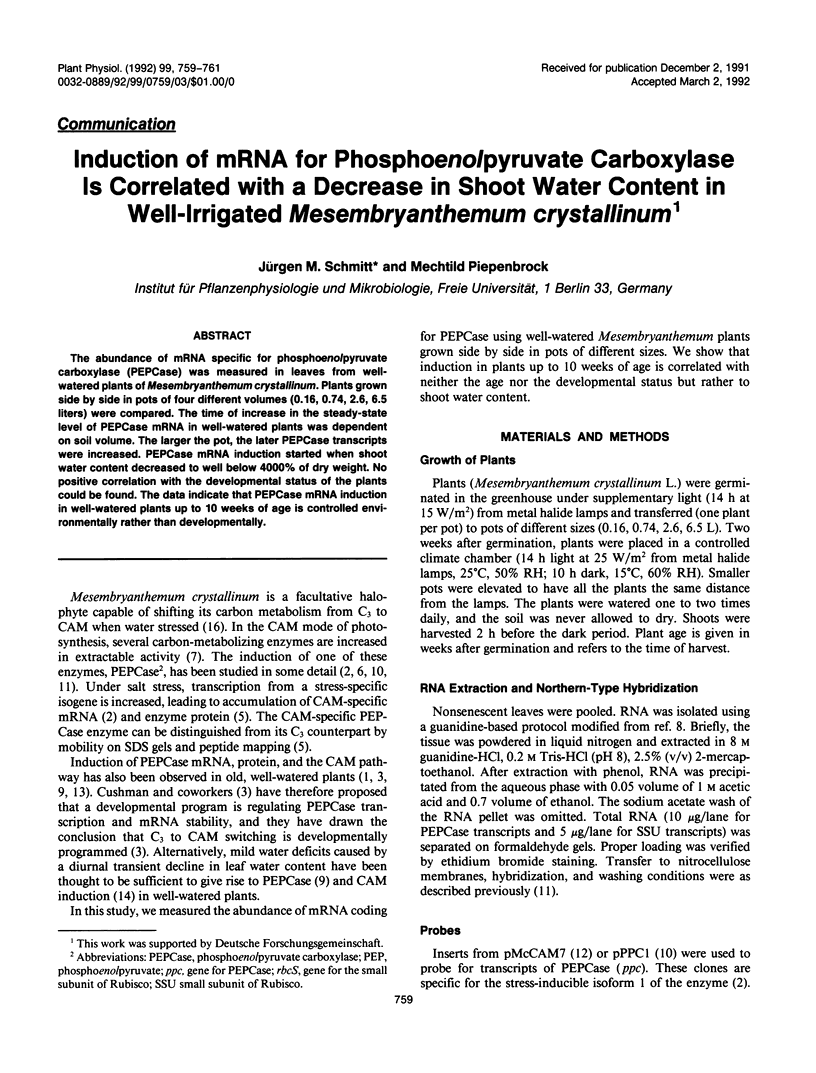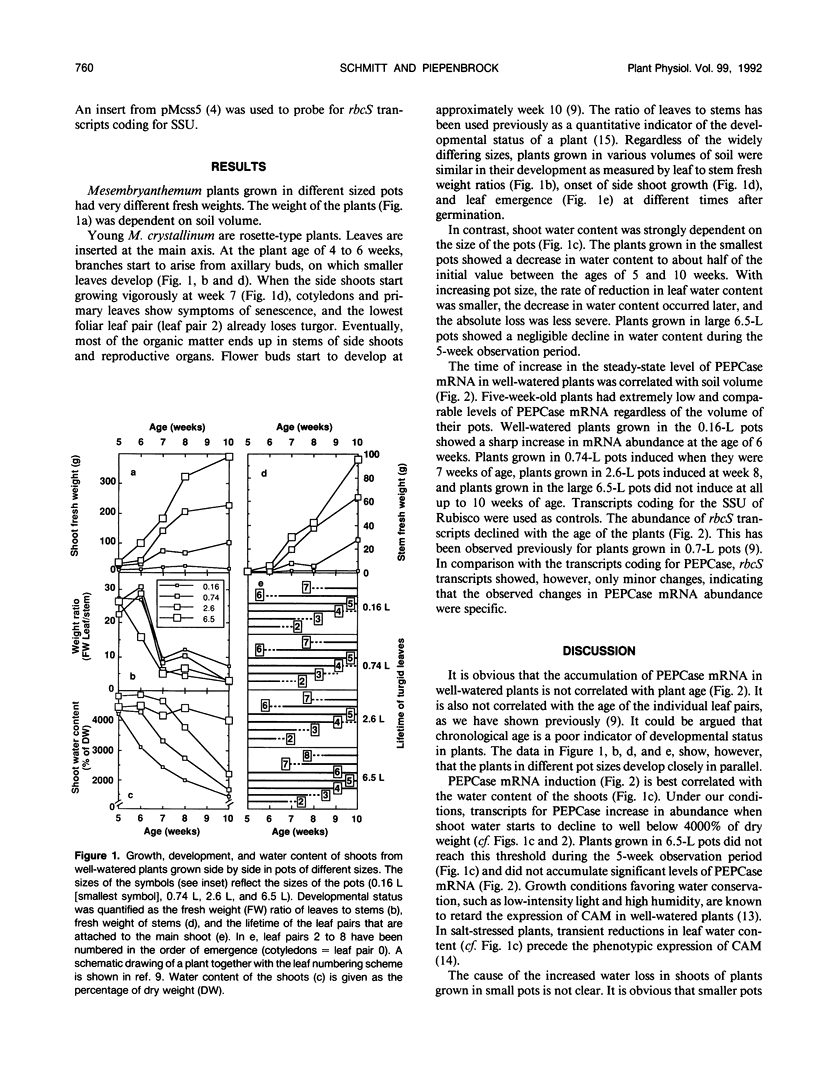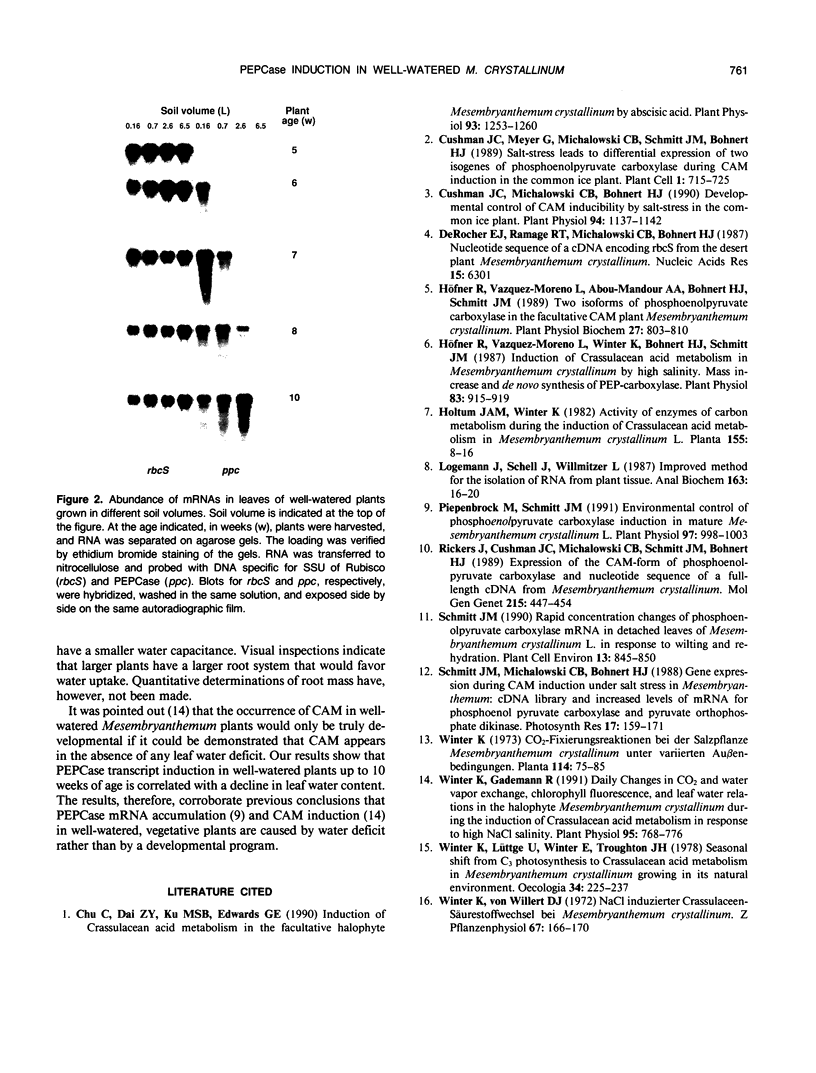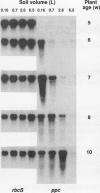Abstract
The abundance of mRNA specific for phosphoenolpyruvate carboxylase (PEPCase) was measured in leaves from well-watered plants of Mesembryanthemum crystallinum. Plants grown side by side in pots of four different volumes (0.16, 0.74, 2.6, 6.5 liters) were compared. The time of increase in the steady-state level of PEPCase mRNA in well-watered plants was dependent on soil volume. The larger the pot, the later PEPCase transcripts were increased. PEPCase mRNA induction started when shoot water content decreased to well below 4000% of dry weight. No positive correlation with the developmental status of the plants could be found. The data indicate that PEPCase mRNA induction in well-watered plants up to 10 weeks of age is controlled environmentally rather than developmentally.
Full text
PDF


Images in this article
Selected References
These references are in PubMed. This may not be the complete list of references from this article.
- Chu C., Dai Z., Ku M. S., Edwards G. E. Induction of Crassulacean Acid Metabolism in the Facultative Halophyte Mesembryanthemum crystallinum by Abscisic Acid. Plant Physiol. 1990 Jul;93(3):1253–1260. doi: 10.1104/pp.93.3.1253. [DOI] [PMC free article] [PubMed] [Google Scholar]
- Cushman J. C., Meyer G., Michalowski C. B., Schmitt J. M., Bohnert H. J. Salt stress leads to differential expression of two isogenes of phosphoenolpyruvate carboxylase during Crassulacean acid metabolism induction in the common ice plant. Plant Cell. 1989 Jul;1(7):715–725. doi: 10.1105/tpc.1.7.715. [DOI] [PMC free article] [PubMed] [Google Scholar]
- Cushman J. C., Michalowski C. B., Bohnert H. J. Developmental control of crassulacean Acid metabolism inducibility by salt stress in the common ice plant. Plant Physiol. 1990 Nov;94(3):1137–1142. doi: 10.1104/pp.94.3.1137. [DOI] [PMC free article] [PubMed] [Google Scholar]
- DeRocher E. J., Ramage R. T., Michalowski C. B., Bohnert H. J. Nucleotide sequence of a cDNA encoding rbcS from the desert plant Mesembryanthemum crystallinum. Nucleic Acids Res. 1987 Aug 11;15(15):6301–6301. doi: 10.1093/nar/15.15.6301. [DOI] [PMC free article] [PubMed] [Google Scholar]
- Höfner R., Vazquez-Moreno L., Winter K., Bohnert H. J., Schmitt J. M. Induction of Crassulacean Acid Metabolism in Mesembryanthemum crystallinum by High Salinity: Mass Increase and de Novo Synthesis of PEP-Carboxylase. Plant Physiol. 1987 Apr;83(4):915–919. doi: 10.1104/pp.83.4.915. [DOI] [PMC free article] [PubMed] [Google Scholar]
- Logemann J., Schell J., Willmitzer L. Improved method for the isolation of RNA from plant tissues. Anal Biochem. 1987 May 15;163(1):16–20. doi: 10.1016/0003-2697(87)90086-8. [DOI] [PubMed] [Google Scholar]
- Piepenbrock M., Schmitt J. M. Environmental Control of Phosphoenolpyruvate Carboxylase Induction in Mature Mesembryanthemum crystallinum L. Plant Physiol. 1991 Nov;97(3):998–1003. doi: 10.1104/pp.97.3.998. [DOI] [PMC free article] [PubMed] [Google Scholar]
- Rickers J., Cushman J. C., Michalowski C. B., Schmitt J. M., Bohnert H. J. Expression of the CAM-form of phospho(enol)pyruvate carboxylase and nucleotide sequence of a full length cDNA from Mesembryanthemum crystallinum. Mol Gen Genet. 1989 Feb;215(3):447–454. doi: 10.1007/BF00427042. [DOI] [PubMed] [Google Scholar]
- Winter K., Gademann R. Daily Changes in CO(2) and Water Vapor Exchange, Chlorophyll Fluorescence, and Leaf Water Relations in the Halophyte Mesembryanthemum crystallinum during the Induction of Crassulacean Acid Metabolism in Response to High NaCl Salinity. Plant Physiol. 1991 Mar;95(3):768–776. doi: 10.1104/pp.95.3.768. [DOI] [PMC free article] [PubMed] [Google Scholar]



